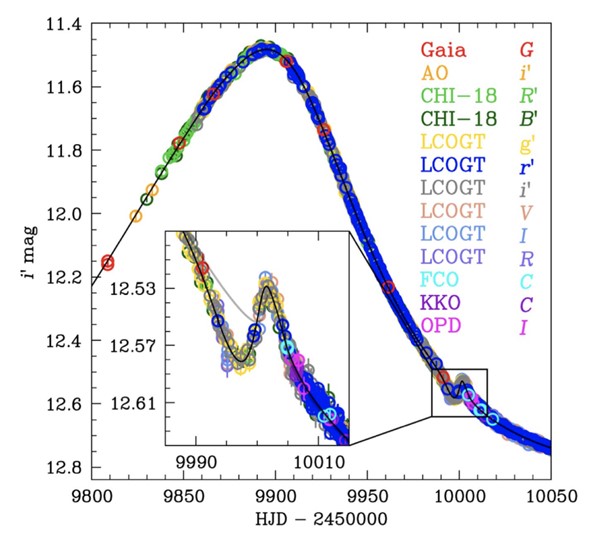
Gaia22dkvLb – a planet with future prospects
Imagine a distant star that works like a cosmic magnifying glass, bending and amplifying the light of an even more distant star that is right behind it. This fascinating trick of gravity is called gravitational microlensing and it aids astronomers in finding microlensing planets that could otherwise remain hidden. When a planet orbits a lens-star, we observe a characteristic clear signature in the changes in brightness of the source star that we call planetary signal. Recent studies focus on Gaia22dkvLb, a newly discovered exoplanet found through microlensing, that can be also observed by measuring radial velocities – something rarely available for those microlensing worlds.
Recent research has focused on Gaia22dkvLb, a newly discovered exoplanet found through microlensing by an international team of scientists, of which mgr Przemysław Mikołajczyk from the Atronomical Institute at the University of Wrocław, is a member. The exoplanet Gaia22dkvLb can also be observed using the radial velocity measurement technique – something rarely achievable for these microlensing worlds.
A planet with future prospects
In this particular case Gaia22dkvLb was detected because its parent star for a short period of time amplified the light of a distant background star. Observations of the Gaia observatory (European Space Agency’s space telescope) and ground observations allowed researchers to identify the microlensing signature of the planet. What makes Gaia22dkvLb particularly exciting is the fact that its parent star is relatively near and bright compared to other similar phenomena, which causes it to be within the range of the radial velocity (RV) method.

What makes Gaia22dkvLb particularly exciting is that its parent star is relatively close and bright compared to other similar phenomena, putting it within range of the radial velocity (RV) method.
The RV technique, the same approach that discovered many exoplanets around Sun-like stars in the past, measures small fluctuations in the movement of a star caused by the orbiting planet. Usually microlensing planets are extremely difficult to track with radial velocity methods because their stars are weak, distant, or unfit for long-term monitoring due to an unfortunate position in the night sky. However, Gaia22dkvLb’s parent star may be bright enough for radial velocity measurement to be possible, giving astronomers a rare chance to gather additional data on the microlensing planet.
Why it matters
The microlensing technique usually only yields basic data on a planet, such as the proportion of its mass to the mass of the parent star, and approximate distance to the system. On the other hand radial velocity measurements allow to reveal a much wider range of information, including the actual mass of the object, orbital period, or additional attributes that combined create a fuller image. Using the radial velocity method to confirm Gaia22dkvLb would be a breakthrough combining two key techniques of detecting planets and enriching our knowledge about the formation of planetary systems in various circumstances.
A glance at alien worlds
This study illustrates the evolving frontier of exoplanet discovery and characterization. Microlensing enables a glance at worlds orbiting stars in the whole galaxy, sometimes thousands of light years away. If Gaia22dkvLb turns out to be observable with radial velocity, it may become one of the few microlensing planets about which we could find out much more than just a blip in the brightness of a distant star – offering astronomers a richer history of an alien world hidden in the Milky Way.
The research also uses spectroscopic data from the SALT (South African Large Telescope) telescope in which the Republic of Poland also has its shares.
P. J. Mikolajczyk’s participation in the research was supported by the OPTICON-RadioNet Pilot project funded by the European Union’s Horizon 2020 innovation and development program (grant agreement no. 101004719).
Source: Faculty of Physics and Astronomy of the University of Wrocław.
Added by: E.K.
Date of publication: 21.02.2025.



